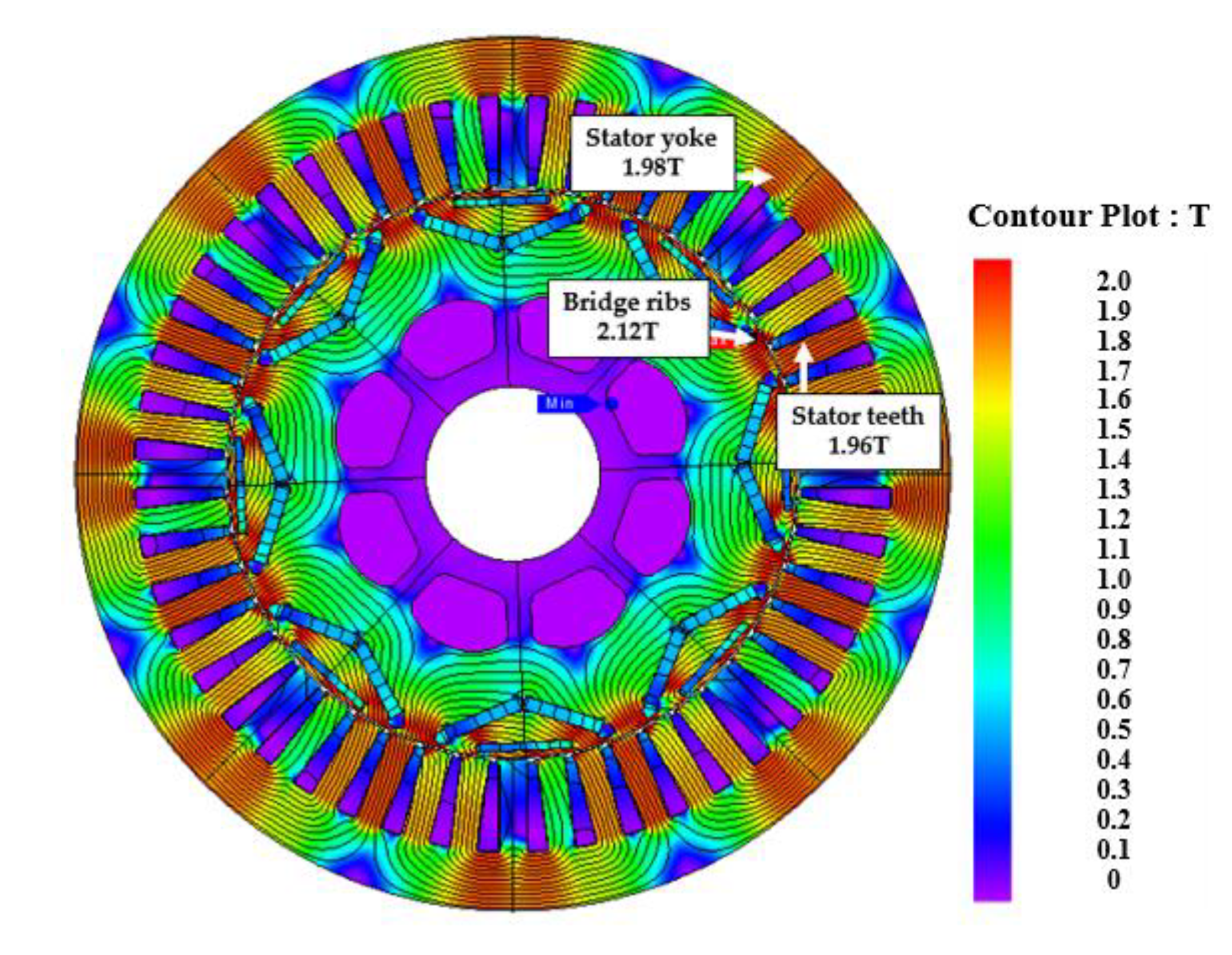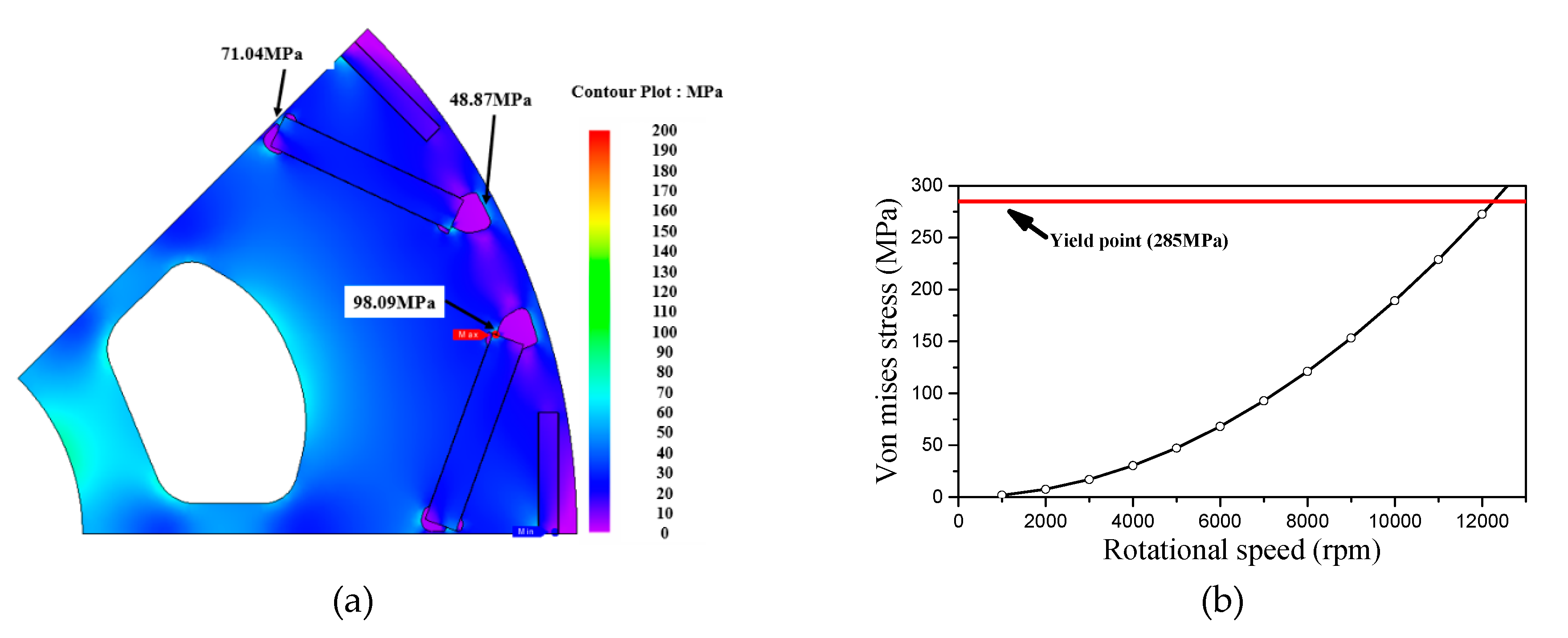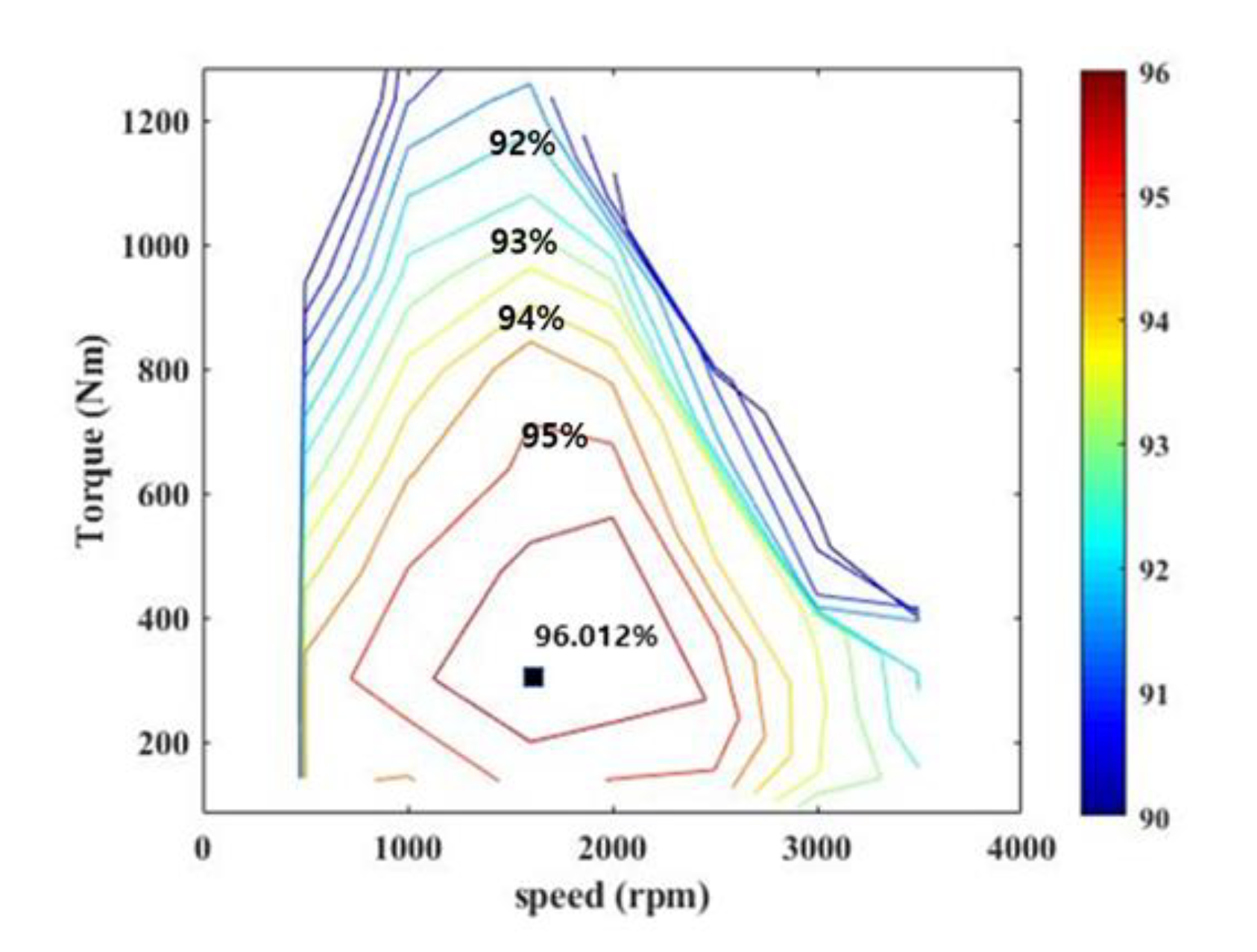Analysis and Design of a High-Performance Traction Motor for Heavy-Duty Vehicles
Abstract
1. Introduction
2. Proposed Analysis and Design Method for a High-Performance Traction Motor for Heavy-Duty Vehicles
Step 1. Determination of the Design Target
Step 2. Selection of Motor Type
Step 3.1. Determination of the Motor Size
Step 3.2. Pole–Slot Number Selection
Step 3.3. Determination of the Winding Method
Step 3.4. Rotor Topology Optimization
Step 4.1. No-Load Analysis
Step 4.2. Load Analysis
Step 5. Mechanical Analysis
Step 6. Experimental Verification
Step 7. Determining the Specifications of the Designed Motor
3. Conclusions
Author Contributions
Funding
Conflicts of Interest
References
- Yu, D.; Huang, X.; Fang, Y.; Zhang, J. Design and comparison of interior permanent magnet synchronous traction motors for high speed railway applications. In Proceedings of the 2017 IEEE Workshop on Electrical Machines Design, Control and Diagnosis, Nottingham, UK, 20–21 April 2017; pp. 58–62. [Google Scholar]
- Raihan, M.A.H.; Smith, K.J.; Almoraya, A.A.; Khan, F. Interior permanent magnet synchronous machine (IPMSM) design for environment friendly hybrid electric vehicle (HEV) applications. In Proceedings of the 2017 IEEE Region 10 Humanitarian Technology Conference (R10-HTC), Dhaka, Bangladesh, 21–23 December 2017; pp. 375–378. [Google Scholar]
- Ma, F.; Yin, H.; Wei, L.; Tian, G.; Gao, H. Design and Optimization of IPM Motor Considering Flux Weakening Capability and Vibration for Electric Vehicle Applications. Sustainability 2018, 10, 1533. [Google Scholar] [CrossRef]
- Bitar, Z.; Al Jabi, S. Studying the Performances of Induction Motor Used in Electric Car. Energy Procedia 2014, 50, 342–351. [Google Scholar] [CrossRef]
- Yang, Z.; Shang, F.; Brown, I.P.; Krishnamurthy, M. Comparative Study of Interior Permanent Magnet, Induction, and Switched Reluctance Motor Drives for EV and HEV Applications. IEEE Trans. Transp. Electrif. 2015, 1, 245–254. [Google Scholar] [CrossRef]
- Wang, J.; Xia, Z.P.; Howe, D. Three-Phase Modular Permanent Magnet Brushless Machine for Torque Boosting on a Downsized ICE Vehicle. IEEE Trans. Veh. Technol. 2005, 54, 809–816. [Google Scholar] [CrossRef]
- Kawano, S.; Murakami, H.; Nishiyama, N.; Ikkai, Y.; Honda, Y.; Higaki, T. High performance design of an interior permanent magnet synchronous reluctance motor for electric vehicles. In Proceedings of the Power Conversion Conference—PCC’97, Nagaoka, Japan, 6 August 2002; Volume 1, pp. 33–36. [Google Scholar]
- Kim, K.-T.; Kim, K.-S.; Hwang, S.-M.; Kim, T.-J.; Jung, Y.-H.; Tae-Jong, K. Comparison of magnetic forces for IPM and SPM motor with rotor eccentricity. IEEE Trans. Magn. 2001, 37, 3448–3451. [Google Scholar]
- Han, J.-H.; Ryu, G.-H.; Lee, K.-D.; Lee, J.-J.; Kim, I.-G.; Jeong, T.-C.; Kim, W.-H.; Lee, J. Optimization in structural design of triangle type IPMSM of permanent magnetic rotor using Box-Behnken methodology. In Proceedings of the 2012 15th International Conference on Electrical Machines and Systems (ICEMS), Sapporo, Japan, 21–24 October 2012; pp. 2–5. [Google Scholar]
- Yeo, H.-K.; Ro, J.-S. Novel Analytical Method for Overhang Effects in Surface-Mounted Permanent-Magnet Machines. IEEE Access 2019, 7, 148453–148461. [Google Scholar] [CrossRef]
- Lee, Y.-S.; Kim, K.-T.; Park, J.-H.; Lee, S.-J.; Chung, T.-K.; Ro, J.-S. Characteristic analysis and design of novel high-frequency shell-type coaxial transformer. IET Electr. Power Appl. 2019, 13, 2027–2034. [Google Scholar] [CrossRef]
- Khan, S.; Bukhari, S.S.H.; Ro, J.-S. Design and Analysis of a 4-kW Two-Stack Coreless Axial Flux Permanent Magnet Synchronous Machine for Low-Speed Applications. IEEE Access 2019, 7, 173848–173854. [Google Scholar] [CrossRef]
- Liu, G.; Xu, G.; Zhao, W.; Du, X.; Chen, Q. Improvement of Torque Capability of Permanent-Magnet Motor by Using Hybrid Rotor Configuration. IEEE Trans. Energy Convers. 2017, 32, 953–962. [Google Scholar] [CrossRef]
- Yang, Y.; Castano, S.M.; Yang, R.; Kasprzak, M.; Bilgin, B.; Sathyan, A.; Dadkhah, H.; Emadi, A. Design and Comparison of Interior Permanent Magnet Motor Topologies for Traction Applications. IEEE Trans. Transp. Electrif. 2016, 3, 86–97. [Google Scholar] [CrossRef]
- Rashidaee, S.; Gholamian, S.A. Reduction of Cogging Torque in IPM Motors by Using the Taguchi and Finite Element Method. Int. J. Comput. Sci. Eng. Surv. 2011, 2, 1–10. [Google Scholar] [CrossRef]
- Mun, J.-M.; Park, G.-J.; Seo, S.; Kim, D.-W.; Kim, Y.-J.; Jung, S.-Y. Design Characteristics of IPMSM with Wide Constant Power Speed Range for EV Traction. IEEE Trans. Magn. 2017, 53, 1. [Google Scholar] [CrossRef]
- Zhang, J.; Wen, X.; Wang, Y.; Li, W. Modeling and analysis of nonlinear interior permanent magnet synchronous motors considering saturation and cross-magnetization effects. In Proceedings of the 2016 IEEE Transportation Electrification Conference and Expo, Asia-Pacific (ITEC Asia-Pacific), Busan, Korea, 1–4 June 2016; pp. 611–615. [Google Scholar]
- Liu, Y.-X.; Li, L.; Cao, J.-W.; Sun, Z.; Sun, Z.-Y.; Zhang, J.-P. The Optimization Design of Short-Term High-Overload Permanent Magnet Motors Considering the Nonlinear Saturation. Energies 2018, 11, 3272. [Google Scholar] [CrossRef]
- Gabdullin, N.; Ro, J.-S. Novel Non-Linear Transient Path Energy Method for the Analytical Analysis of the Non-Periodic and Non-Linear Dynamics of Electrical Machines in the Time Domain. IEEE Access 2019, 7, 37833–37854. [Google Scholar] [CrossRef]
- Sim, M.-S.; Ro, J.-S. Analysis of an eddy current brake for an actuator of a high-voltage direct current circuit breaker. IET Electr. Power Appl. 2019, 13, 1387–1391. [Google Scholar] [CrossRef]
- Ştirban, A.; Tutelea, L.; Iles-Klumpner, D.; Boldea, I. FEM analysis of concentrated coils nonuniform slot (6+6/8) IPMSM fed with trapezoidal current. In Proceedings of the 11th International Conference on Optimization of Electrical and Electronic Equipment, Brasov, Romania, 22–24 May 2008; pp. 45–53. [Google Scholar]
- Zhu, Z.Q.; Wu, D.; Ge, X. Investigation of Voltage Distortion in Fractional Slot Interior Permanent Magnet Machines Having Different Slot and Pole Number Combinations. IEEE Trans. Energy Convers. 2016, 31, 1192–1201. [Google Scholar] [CrossRef]
- Ge, X.; Zhu, Z.Q. Sensitivity of Manufacturing Tolerances on Cogging Torque in Interior Permanent Magnet Machines With Different Slot/Pole Number Combinations. IEEE Trans. Ind. Appl. 2017, 53, 3557–3567. [Google Scholar] [CrossRef]
- Tangudu, J.K.; Jahns, T.M.; Bohn, T.P. Design, analysis and loss minimization of a fractional-slot concentrated winding IPM machine for traction applications. In Proceedings of the 2011 IEEE Energy Conversion Congress and Exposition, Phoenix, AZ, USA, 17–22 September 2011; pp. 2236–2243. [Google Scholar]
- Gabdullin, N.; Ro, J.-S. Energy-Efficient Eco-Friendly Zero-Holding-Energy Magnetic Contactor for Industrial and Vehicular Applications. IEEE Trans. Veh. Technol. 2020, 69, 5000–5011. [Google Scholar] [CrossRef]
- Lim, M.-S.; Chai, S.-H.; Hong, J.-P. Design of Saliency-Based Sensorless-Controlled IPMSM with Concentrated Winding for EV Traction. IEEE Trans. Magn. 2015, 52, 1–4. [Google Scholar] [CrossRef]
- Alsawalhi, J.Y.; Sudhoff, S.D. Design Optimization of Asymmetric Salient Permanent Magnet Synchronous Machines. IEEE Trans. Energy Convers. 2016, 31, 1315–1324. [Google Scholar] [CrossRef]
- Lee, K.-D.; Lee, J.; Lee, H.W. Inductance Calculation of Flux Concentrating Permanent Magnet Motor through Non-Linear Magnetic Equivalent Circuit. IEEE Trans. Magn. 2015, 51, 1. [Google Scholar]
- Liang, J.; Parsapour, A.; Yang, Z.; Caicedo-Narvaez, C.; Moallem, M.; Fahimi, B. Optimization of Air-Gap Profile in Interior Permanent-Magnet Synchronous Motors for Torque Ripple Mitigation. IEEE Trans. Transp. Electrif. 2019, 5, 118–125. [Google Scholar] [CrossRef]
- Maema, A.; Shimomura, S.; Kono, M. Mathematical model considering air gap space harmonics in IPMSM. In Proceedings of the 19th International Conference on Electrical Machines and Systems (ICEMS), Chiba, Japan, 13–16 November 2016; pp. 1–6. [Google Scholar]
- Honda, Y.; Higaki, T.; Morimoto, S.; Takeda, Y. Rotor design optimisation of a multi-layer interior permanent-magnet synchronous motor. IEE Proc. Electr. Power Appl. 1998, 145, 119. [Google Scholar] [CrossRef]
- Gabdullin, N.; Ro, J.-S. Analysis of Nonlinear Dynamics of Permanent Magnet Magnetic Contactor via Novel Computationally Efficient Analytical Method Considering Stray and Leakage Fluxes. IEEE Access 2020, 8, 57273–57282. [Google Scholar] [CrossRef]
- Guan, B.; Zhao, Y.; Ruan, Y. Torque Ripple Minimization in Interior PM Machines using FEM and Multiple Reference Frames. In Proceedings of the 2006 1ST IEEE Conference on Industrial Electronics and Applications, Singapore, 24–26 May 2006; pp. 1–6. [Google Scholar]
- Jung, Y.-H.; Lim, M.-S.; Yoon, M.-H.; Jeong, J.-S.; Hong, J.-P. Torque Ripple Reduction of IPMSM Applying Asymmetric Rotor Shape under Certain Load Condition. IEEE Trans. Energy Convers. 2018, 33, 333–340. [Google Scholar] [CrossRef]
- Luu, P.T.; Lee, J.-Y.; Hwang, W.; Woo, B.-C. Cogging Torque Reduction Technique by Considering Step-Skew Rotor in Permanent Magnet Synchronous Motor. In Proceedings of the 2018 21st International Conference on Electrical Machines and Systems (ICEMS), IEEE, Jeju, South Korea, 7–10 October 2018; pp. 219–223. [Google Scholar]
- Kim, T.-W.; Chang, J.-H. Influence of Cogging Torque Reduction Method on Torque Ripple in a Surface-Mounted Permanent Magnet Synchronous Motor. J. Magn. 2012, 17, 109–114. [Google Scholar] [CrossRef]
- Gomez, D.J.; Tovar-Barranco, A.; Rodriguez, A.L.; Lopez-De-Heredia, A.; Villar, I. On-load cogging torque calculation using Frozen Permeability method and permeance network models. In Proceedings of the 2016 XXII International Conference on Electrical Machines (ICEM), IEEE, Lausanne, Switzerland, 4–7 September 2016; pp. 499–505. [Google Scholar]
- Zhang, G.; Yu, W.; Hua, W.; Cao, R.; Qiu, H.; Guo, A. The Design and Optimization of an Interior, Permanent Magnet Synchronous Machine Applied in an Electric Traction Vehicle Requiring a Low Torque Ripple. Appl. Sci. 2019, 9, 3634. [Google Scholar] [CrossRef]
- Kim, T.-W.; Chang, J.-H. Effective step-skew method for cogging torque reduction in surface-mounted permanent magnet synchronous motor. J. Korean Phys. Soc. 2013, 63, 288–292. [Google Scholar] [CrossRef]
- Ge, X.; Zhu, Z.Q.; Kemp, G.; Moule, D.; Williams, C. Optimal step-skew methods for cogging torque reduction accounting for three-dimensional effect of interior permanent magnet machines. IEEE Trans. Energy Convers. 2017, 32, 222–232. [Google Scholar] [CrossRef]
- Chen, Q.; Xu, G.; Liu, G.; Zhao, W.; Liu, L.; Lin, Z. Torque Ripple Reduction in Five-Phase IPM Motors by Lowering Interactional MMF. IEEE Trans. Ind. Electron. 2018, 65, 8520–8531. [Google Scholar] [CrossRef]
- Kato, T.; Matsuura, T.; Sasaki, K.; Tanimoto, T. Principle of variable leakage flux IPMSM using arc-shaped magnet considering variable motor parameter characteristics depending on load current. In Proceedings of the 2017 IEEE Energy Conversion Congress and Exposition (ECCE), Cincinnati, OH, USA, 1–5 October 2017; pp. 5803–5810. [Google Scholar]
- Honda, Y.; Nakamura, T.; Higaki, T.; Takeda, Y. Motor design considerations and test results of an interior permanent magnet synchronous motor for electric vehicles. In Proceedings of the IAS ’97, Conference Record of the 1997 IEEE Industry Applications Conference Thirty-Second IAS Annual Meeting, New Orleans, LA, USA, 5–9 October 1997; Volume 1, pp. 75–82. [Google Scholar]
- Zhang, Y.; Cao, W.; McLoone, S.; Morrow, D.J. Design and Flux-Weakening Control of an Interior Permanent Magnet Synchronous Motor for Electric Vehicles. IEEE Trans. Appl. Supercond. 2016, 26, 1–6. [Google Scholar] [CrossRef]
- Okamoto, S.; Denis, N.; Kato, Y.; Ieki, M.; Fujisaki, K. Core Loss Reduction of an Interior Permanent-Magnet Synchronous Motor Using Amorphous Stator Core. IEEE Trans. Ind. Appl. 2016, 52, 2261–2268. [Google Scholar] [CrossRef]
- Yamazaki, K.; Seto, Y. Iron loss analysis of interior permanent magnet synchronous motors variation of main loss factors due to driving condition. IEEE Int. Conf. Electr. Mach. Driv. 2005, 42, 1633–1638. [Google Scholar]
- Mahmoud, H.; Bacco, G.; Degano, M.; Bianchi, N.; Gerada, C. Synchronous Reluctance Motor Iron Losses: Considering Machine Nonlinearity at MTPA, FW, and MTPV Operating Conditions. IEEE Trans. Energy Convers. 2018, 33, 1402–1410. [Google Scholar] [CrossRef]
- Cha, K.-S.; Kim, D.-M.; Park, M.-R.; Yoon, M.-H.; Hong, J.-P. Multipolar High-Speed IPMSM Design for EV Traction Considering Mechanical Stress. In Proceedings of the 2016 IEEE 84th Vehicular Technology Conference (VTC-Fall), Montreal, QC, Canada, 18–21 September 2016; pp. 1–6. [Google Scholar]














| Current (A) | Average Torque (Nm) | Torque Ripple (%) |
|---|---|---|
| 200 | 651.8 | 3.2 |
| 420 | 1277.87 | 3.5 |
| Components | Parameters | Target |
|---|---|---|
| Stator | Slots number | 48 |
| Outer diameter (mm) | 400 | |
| Inner diameter (mm) | 262 | |
| Winding | Turns number (turn) | 5 |
| Coil resistance (Ω) | 0.01178 | |
| Rotor | Poles number | 8 |
| Outer diameter (mm) | 260 | |
| Inner diameter (mm) | 80 | |
| Skew angle (°) | 7.5 | |
| Motor | Axial length (mm) | 130 |
| Iron core material | 50JN470 | |
| Permanent magnet material | N39UH (Nd-Fe-B Magnet) | |
| Remanence of PM (T) | 1.23 | |
| Current density (A/) | 10.4 | |
| Cooling method | Water cooling |
| Characteristics | FEM Results | Experiment Results |
|---|---|---|
| Maximum torque (Nm) | 1277.87 | 126,754 |
| Maximum power (kW) | 303.09 | 285.07 |
| Maximum efficiency (%) | 98.13 | 96.01 |
| Maximum speed (rpm) | 9000 | 6000 |
| Maximum voltage () | 490 | 490 |
© 2020 by the authors. Licensee MDPI, Basel, Switzerland. This article is an open access article distributed under the terms and conditions of the Creative Commons Attribution (CC BY) license (http://creativecommons.org/licenses/by/4.0/).
Share and Cite
Lee, D.-K.; Ro, J.-S. Analysis and Design of a High-Performance Traction Motor for Heavy-Duty Vehicles. Energies 2020, 13, 3150. https://doi.org/10.3390/en13123150
Lee D-K, Ro J-S. Analysis and Design of a High-Performance Traction Motor for Heavy-Duty Vehicles. Energies. 2020; 13(12):3150. https://doi.org/10.3390/en13123150
Chicago/Turabian StyleLee, Dong-Kyu, and Jong-Suk Ro. 2020. "Analysis and Design of a High-Performance Traction Motor for Heavy-Duty Vehicles" Energies 13, no. 12: 3150. https://doi.org/10.3390/en13123150
APA StyleLee, D.-K., & Ro, J.-S. (2020). Analysis and Design of a High-Performance Traction Motor for Heavy-Duty Vehicles. Energies, 13(12), 3150. https://doi.org/10.3390/en13123150





